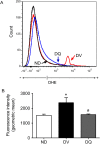Renoprotective, anti-oxidative and anti-apoptotic effects of oral low-dose quercetin in the C57BL/6J model of diabetic nephropathy
- PMID: 25481305
- PMCID: PMC4271322
- DOI: 10.1186/1476-511X-13-184
Renoprotective, anti-oxidative and anti-apoptotic effects of oral low-dose quercetin in the C57BL/6J model of diabetic nephropathy
Abstract
Background: Diabetic nephropathy (DN) is one of the major causes of end-stage renal disease in diabetic patients. Increasing evidence from studies in the rodents has suggested that this disease is associated with increased oxidative stress due to hyperglycemia. In the present study, we evaluated the renoprotective, anti-oxidative and anti-apoptotic effects of the flavonoid quercetin in C57BL/6J model of DN.
Methods: DN was induced by streptozotocin (STZ, 100 mg/kg/day, for 3 days) in adult C57BL/6J mice. Six weeks later, mice were divided into the following groups: diabetic mice treated with quercetin (DQ, 10 mg/kg/day, 4 weeks), diabetic mice treated with vehicle (DV) or non-treated non-diabetic (ND) mice.
Results: Quercetin treatment caused a reduction in polyuria (~45%) and glycemia (~35%), abolished the hypertriglyceridemia and had significant effects on renal function including, decreased proteinuria and high plasma levels of uric acid, urea and creatinine, which were accompanied by beneficial effects on the structural changes of the kidney including glomerulosclerosis. Flow cytometry showed a decrease in oxidative stress and apoptosis in DN mice.
Conclusion: Taken together, these data show that quercetin effectively attenuated STZ-induced cytotoxicity in renal tissue. This study provides convincing experimental evidence and perspectives on the renoprotective effects of quercetin in diabetic mice and outlines a novel therapeutic strategy for this flavonoid in the treatment of DN.
Figures






Similar articles
-
Anti-diabetic and renoprotective effects of aliskiren in streptozotocin-induced diabetic nephropathy in female rats.Naunyn Schmiedebergs Arch Pharmacol. 2016 Dec;389(12):1315-1324. doi: 10.1007/s00210-016-1299-2. Epub 2016 Sep 9. Naunyn Schmiedebergs Arch Pharmacol. 2016. PMID: 27612855
-
The protective effects of oral low-dose quercetin on diabetic nephropathy in hypercholesterolemic mice.Front Physiol. 2015 Sep 2;6:247. doi: 10.3389/fphys.2015.00247. eCollection 2015. Front Physiol. 2015. PMID: 26388784 Free PMC article.
-
Quercetin liposomes ameliorate streptozotocin-induced diabetic nephropathy in diabetic rats.Sci Rep. 2020 Feb 12;10(1):2440. doi: 10.1038/s41598-020-59411-7. Sci Rep. 2020. PMID: 32051470 Free PMC article.
-
Oxidative stress and inflammation in diabetic nephropathy: role of polyphenols.Front Immunol. 2023 Jul 21;14:1185317. doi: 10.3389/fimmu.2023.1185317. eCollection 2023. Front Immunol. 2023. PMID: 37545494 Free PMC article. Review.
-
Mechanistic insight of diabetic nephropathy and its pharmacotherapeutic targets: An update.Eur J Pharmacol. 2016 Nov 15;791:8-24. doi: 10.1016/j.ejphar.2016.08.022. Epub 2016 Aug 25. Eur J Pharmacol. 2016. PMID: 27568833 Review.
Cited by
-
Worsening of Oxidative Stress, DNA Damage, and Atherosclerotic Lesions in Aged LDLr-/- Mice after Consumption of Guarana Soft Drinks.Oxid Med Cell Longev. 2019 Jun 10;2019:9042526. doi: 10.1155/2019/9042526. eCollection 2019. Oxid Med Cell Longev. 2019. PMID: 31281596 Free PMC article.
-
Coadjuvants in the Diabetic Complications: Nutraceuticals and Drugs with Pleiotropic Effects.Int J Mol Sci. 2016 Aug 5;17(8):1273. doi: 10.3390/ijms17081273. Int J Mol Sci. 2016. PMID: 27527163 Free PMC article. Review.
-
Network Pharmacology Combined with Bioinformatics to Investigate the Mechanisms and Molecular Targets of Astragalus Radix-Panax notoginseng Herb Pair on Treating Diabetic Nephropathy.Evid Based Complement Alternat Med. 2021 Jul 24;2021:9980981. doi: 10.1155/2021/9980981. eCollection 2021. Evid Based Complement Alternat Med. 2021. PMID: 34349833 Free PMC article.
-
Short-term High Dose of Quercetin and Resveratrol Alters Aging Markers in Human Kidney Cells.Int J Prev Med. 2017 Aug 31;8:64. doi: 10.4103/ijpvm.IJPVM_139_17. eCollection 2017. Int J Prev Med. 2017. PMID: 28966753 Free PMC article.
-
Quercetin and Catechin Protects Leptin-Deficient Lepob/Ob Mice Against Alloxan-Induced Diabetes and Hepatotoxicity via Suppression of Oxidative Stress and Inflammation.Rep Biochem Mol Biol. 2024 Jul;13(2):184-195. doi: 10.61186/rbmb.13.2.184. Rep Biochem Mol Biol. 2024. PMID: 39995646 Free PMC article.
References
-
- Vallon V, Rose M, Gerasimova M, Satriano J, Platt KA, Koepsell H, Cunard R, Sharma K, Thomson SC, Rieg T. Knockout of Na-glucose transporter SGLT2 attenuates hyperglycemia and glomerular hyperfiltration but not kidney growth or injury in diabetes mellitus. Am J Physiol Renal Physiol. 2013;304(2):F156–F167. doi: 10.1152/ajprenal.00409.2012. - DOI - PMC - PubMed
Publication types
MeSH terms
Substances
LinkOut - more resources
Full Text Sources
Other Literature Sources
Medical

